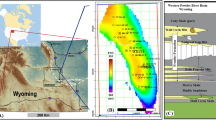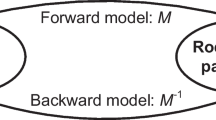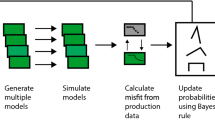Abstract
Predicting the spatial configuration of geological facies is a key step in the reservoir modeling process. The productivity of a reservoir depends not only on the facies proportions but also on the spatial patterns of the facies sequence. The recent developments in seismic to facies inversion techniques use \(1\mathrm{st}\)-order Markov models to improve the geological realism of the inferred facies profiles. However, the emergence of deep learning techniques such as recursive neural networks shows promising results in predictive modeling of event sequences as shown by the successful applications in complex modeling problems, such as natural language processing. In this work, a comparison between hidden Markov models and recursive neural networks is presented to highlight their advantages and disadvantages. The results are discussed according to the prior assumptions related to facies proportions and sequence patterns. Then, an innovative approach integrating recursive neural networks and the state-of-the-art seismic to facies inversion, known as the convolutional hidden Markov model, is proposed in order to predict geologically more realistic facies sequences based on seismic data. The proposed inversion technique is validated using synthetic seismic data in the context of a complex geological environment.











Similar content being viewed by others
References
Bishop CM (2006) Pattern recognition and machine learning. Springer, Berlin
Bortfeld R (1961) Approximations to the reflection and transmission coefficients of plane longitudinal and transverse waves. Geophys Prospect 9:485–502
Buland A, Omre H (2003) Bayesian linearized avo inversion. Geophysics 68(1):185–198
Caers J, Ma X (2002) Modeling conditional distributions of facies from seismic using neural nets. Math Geol 34(2):143–167
Chen C, Hiscott RN (1999) Statistical analysis of facies clustering in submarine-fan turbidite successions. J Sediment Res 69(2):505–517
Cong S, Liang Y (2009) Pid-like neural network nonlinear adaptive control for uncertain multivariable motion control systems. IEEE Trans Industr Electron 56(10):3872–3879
Connolly PA, Hughes MJ (2016) Stochastic inversion by matching to large numbers of pseudo-wells. Geophysics 81:M7–M22
Da Veiga S, Le Ravalec M (2012) Maximum likelihood classification for facies inference from reservoir attributes. Comput Geosci 16(3):709–722
Doyen P (2007) Seismic reservoir characterization: an earth modelling perspective, vol 2. EAGE Publications, Houten
Dubois MK, Bohling GC, Chakrabarti S (2007) Comparison of four approaches to a rock facies classification problem. Comput Geosci 33(5):599–617
Dubrule O (2003) Geostatistics for seismic data integration in earth models. SEG Distinguished Instructor Short Course
Eidsvik J, Mukerji T, Switzer P (2004) Estimation of geological attributes from a well log, an application of hidden Markov chains. Math Geol 36(3):379–397
Elfeki A, Dekking M (2001) A markov chain model for subsurface characterization: theory and applications. Math Geol 33(5):569–589
Fan L, Poh KL (2007) A comparative study of pca, ica and class-conditional ica for naïve Bayes classifier. In: International work-conference on artificial neural networks, Springer, pp 16–22
de Figueiredo LP, Grana D, Roisenberg M, Rodrigues BB (2019a) Gaussian mixture markov chain monte carlo method for linear seismic inversion. Geophysics 84(3):R463–R476
de Figueiredo LP, Grana D, Roisenberg M, Rodrigues BB (2019b) Multimodal markov chain monte carlo method for nonlinear petrophysical seismic inversion. Geophysics 84(5):M1–M13
Fjeldstad T (2015) Bayesian inversion and inference of categorical markov models with likelihood functions including dependence and convolution. Master’s thesis, Norwegian University of Science and Technology
Fjeldstad T, Grana D (2017) Joint probabilistic petrophysics-seismic inversion based on gaussian mixture and markov chain prior models. Geophysics 83:1–46
Goodfellow I, Bengio Y, Courville A, Bengio Y (2016) Deep learning, vol 1. MIT Press, Cambridge
Graf W, Freitag S, Kaliske M, Sickert JU (2010) Recurrent neural networks for uncertain time-dependent structural behavior. Comput Aided Civil Infrast Eng 25(5):322–323
Grana D, Pirrone M, Mukerji T (2012) Quantitative log interpretation and uncertainty propagation of petrophysical properties and facies classification from rock-physics modeling and formation evaluation analysis. Geophysics 77(3):WA45–WA63
Grana D, Fjeldstad T, Omre H (2017) Bayesian gaussian mixture linear inversion for geophysical inverse problems. Math Geosci 49:493–515
Guo C, Pleiss A, Sun Y, Weinberger KQ (2017) On calibration of modern neural networks. In: 34th international conference on machine learning, pp 1321–1330
Hall B (2016) Facies classification using machine learning. Lead Edge 35(10):906–909
Hall M, Hall B (2017) Distributed collaborative prediction: results of the machine learning contest. Lead Edge 36(3):267–269
Hastie T, Tibshirani R, Friedman J (2009) The elements of statistical learning: data mining, inference, and prediction. Springer, Berlin
Hochreiter S, Schmidhuber J (1997a) Long short-term memory. Neural Comput 9(8):1735–1780. https://doi.org/10.1162/neco.1997.9.8.1735
Hochreiter S, Schmidhuber J (1997b) Long short-term memory. Neural Comput 9(8):1735–1780
Krumbein WC, Dacey MF (1969) Markov chains and embedded Markov chains in geology. J Int Assoc Math Geol 1(1):79–96
Larsen AL, Ulvmoen M, Omre H, Buland A (2006) Bayesian lithology fluid prediction and simulation on the basis of a markov-chain prior model. Geophysics 71(5):R69–R78
Li Y, Anderson-Sprecher R (2006) Facies identification from well logs: A comparison of discriminant analysis and naïve Bayes classifier. J Petrol Sci Eng 53(3–4):149–157
Lin FJ, Wai RJ, Chou WD, Hsu SP (2002) Adaptive backstepping control using recurrent neural network for linear induction motor drive. IEEE Trans Industr Electron 49(1):134–146
Lindberg DV, Grana D (2015) Petro-elastic log-facies classification using the Expectation Maximization algorithm and hidden Markov models. Math Geosci 47(6):719–752
Maniar H, Ryali S, Kulkarni MS, Abubakar A (2018) Machine-learning methods in geoscience. In: SEG Technical Program Expanded Abstracts 2018, Society of Exploration Geophysicists, pp 4638–4642
Mozafari A, Gomes H, Leão W, Janny S, Gagné C (2019) Attended temperature scaling: a practical approach for calibrating deep neural networks. Mach Learn
Mukerji T, Jørstad A, Avseth P, Mavko G, Granli J (2001) Mapping lithofacies and pore-fluid probabilities in a north sea reservoir: seismic inversions and statistical rock physics. Geophysics 66(4):988–1001
Park BS, Yoo SJ, Park JB, Choi YH (2008) Adaptive neural sliding mode control of nonholonomic wheeled mobile robots with model uncertainty. IEEE Trans Control Syst Technol 17(1):207–214
Rimstad K, Omre H (2013) Approximate posterior distributions for convolutional two-level hidden markov models. Comput Stat Data Anal 53:187–200
Sak H, Senior A, Beaufays F (2014) Long short-term memory recurrent neural network architectures for large scale acoustic modeling. In: Fifteenth annual conference of the international speech communication association, pp 347–352
Scheidt C, Caers J (2009) Representing spatial uncertainty using distances and kernels. Math Geosci 41(4):397
Sherstinsky A (2020) Fundamentals of recurrent neural network (rnn) and long short-term memory (lstm) network. Physica D: Nonlinear Phenomena 404:132306. https://doi.org/10.1016/j.physd.2019.132306. http://www.sciencedirect.com/science/article/pii/S0167278919305974
Stolt R, Weglein A (1985) Migration and inversion of seismic data. Geophysics 50:2458–2472
Talarico E (2018) Seismic to facies inversion using convolved hidden markov model. Master’s thesis, Pontifical Catholic University of Rio de Janeiro
Tian M, Omre H, Xu H (2021) Inversion of well logs into lithology classes accounting for spatial dependencies by using hidden markov models and recurrent neural networks. Journal of Petroleum Science and Engineering 196:107598.https://doi.org/10.1016/j.petrol.2020.107598. http://www.sciencedirect.com/science/article/pii/S0920410520306665
Ulvmoen M, Omre H (2010) Improved resolution in bayesian lithology/fluid inversion from prestack seismic data and well observations: Part 1 - methodology. Geophysics 75(2):R21–R35
Ulvmoen M, Omre H, Buland A (2010) Improved resolution in bayesian lithology/fluid inversion from prestack seismic data and well observations: Part 2 - real case study. Geophysics 75(2):B73–B82
Wang G, Carr TR, Ju Y, Li C (2014) Identifying organic-rich Marcellus Shale lithofacies by support vector machine classifier in the Appalachian basin. Comput Geosci 64:52–60
Author information
Authors and Affiliations
Corresponding author
Rights and permissions
About this article
Cite this article
Talarico, E., Leão, W. & Grana, D. Comparison of Recursive Neural Network and Markov Chain Models in Facies Inversion. Math Geosci 53, 395–413 (2021). https://doi.org/10.1007/s11004-020-09914-w
Received:
Accepted:
Published:
Issue Date:
DOI: https://doi.org/10.1007/s11004-020-09914-w




